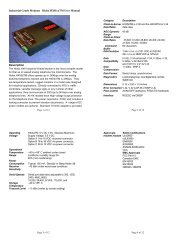Create successful ePaper yourself
Turn your PDF publications into a flip-book with our unique Google optimized e-Paper software.
<strong>AT</strong> <strong>Commands</strong> <strong>Reference</strong> <strong>Manual</strong><br />
Data Call State Model<br />
For purposes of this command, there are four data call states, and associated status issues:<br />
• Call Setup<br />
− Calling DCE: get dial tone, generate dial digits, detect call progress signals.<br />
− Answering DCE: detect ringing, detect CallerID, etc.<br />
• Negotiation<br />
− V.25 calling tone/answer tone exchanges<br />
− V.8 or V.8bis call function negotiations<br />
− V-series modem carrier detection and training<br />
− Modem-to-modem protocols (e.g., V.42, V.42bis).<br />
• Data Transfer<br />
− Bit-error rates, for each direction<br />
− Rate renegotiation<br />
− Retraining<br />
• Call Termination<br />
− protocol disconnect signals<br />
− carrier disconnect signals<br />
− loss of carrier<br />
− excessive error rates<br />
Command Syntax<br />
In response to this command, the modem will report one or more lines of information text<br />
as defined below. Information text format conforms to V.250; each line is preceded by a<br />
pair, and terminated by . (CR and LF characters may be changed<br />
by writing new values to the contents of registers S3 and S4, respectively.)<br />
The modem may generate a single line or multiple lines, followed by a standard OK final<br />
result code. For example, if call setup failed, only that result is useful. Each information<br />
text line is formatted as follows, including one or more key=value pairs:<br />
Syntax<br />
#UD<br />
Response<br />
DIAG <br />
100722B Conexant 3-79








